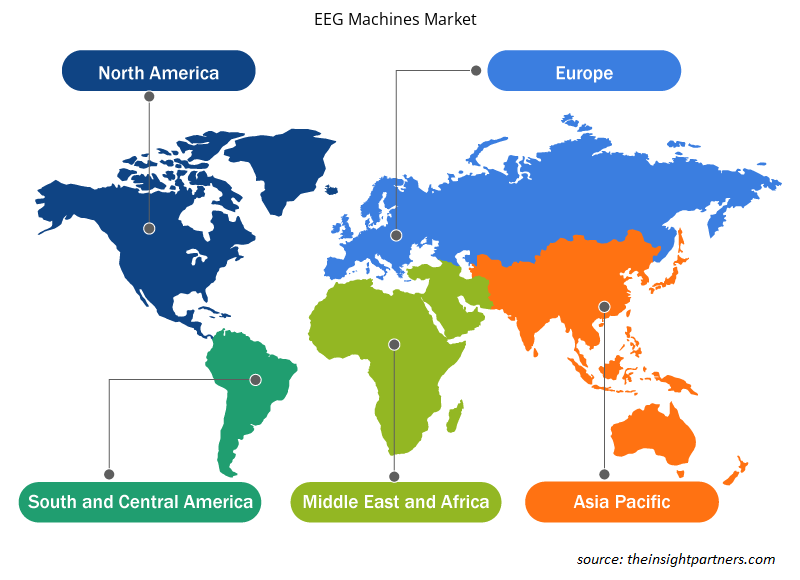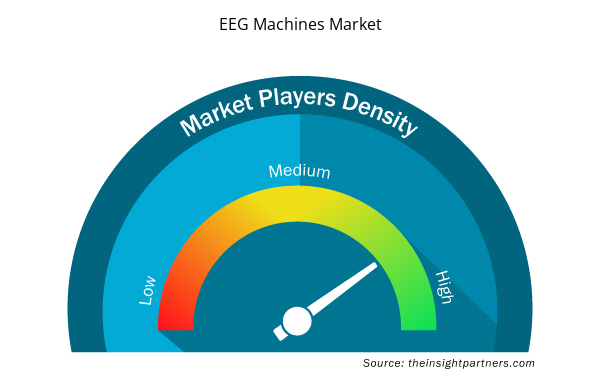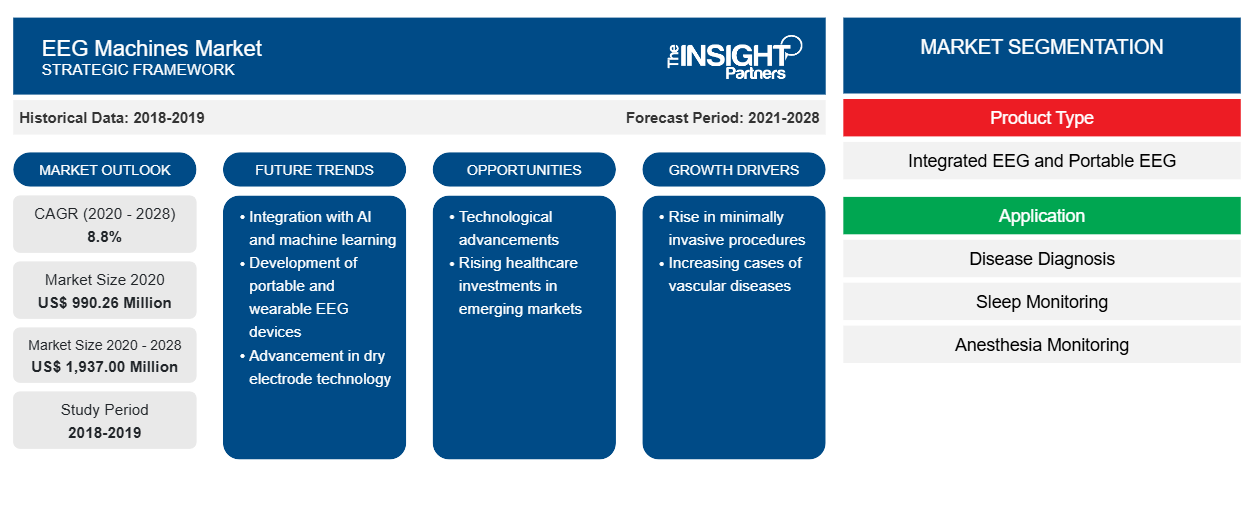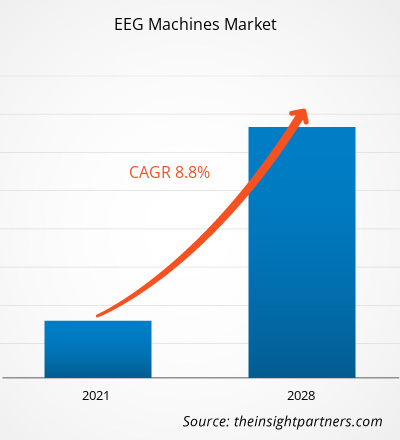[Rapporto di ricerca] Il mercato delle macchine EEG è stato valutato a 990,26 milioni di dollari nel 2020 e si prevede che raggiungerà 1.937,00 milioni di dollari entro il 2028; si prevede che crescerà a un CAGR dell'8,8% dal 2021 al 2028.CAGR of 8.8% from 2021 to 2028.
Un apparecchio per elettroencefalografia (EEG) è un dispositivo medico che aiuta i professionisti sanitari a monitorare i segnali elettrici del cervello. I segnali elettrici trasmessi sono relativamente deboli e quindi richiedono amplificazione. Un amplificatore viene utilizzato per ingrandire la tensione. Le letture di un apparecchio EEG vengono utilizzate per diagnosticare vari disturbi neurologici e monitorare i disturbi del sonno e i pazienti sotto anestesia durante procedure mediche come la chirurgia. L'apparecchiatura funziona con l'aiuto di elettrodi attaccati al cuoio capelluto per raccogliere la lettura delle onde cerebrali. L'apparecchio EEG è utilizzato principalmente in ospedali, laboratori diagnostici e centri chirurgici ambulatoriali.
Il mercato delle macchine EEG è segmentato in base al tipo di prodotto, all'applicazione, all'utente finale e alla geografia. In base alla geografia, il mercato è segmentato in Nord America, Europa, Asia Pacifico, Medio Oriente e Africa e Sud e Centro America. Il rapporto offre approfondimenti e analisi approfondite del mercato delle macchine EEG, sottolineando vari parametri come tendenze di mercato, progressi tecnologici, dinamiche di mercato e analisi del panorama competitivo dei principali attori del mercato in tutto il mondo. Include anche un'analisi dell'impatto del COVID-19 in tutte le regioni. Si stima che il mercato avrà probabilmente un tasso di crescita più lento durante il periodo di previsione a causa dei servizi sanitari limitati e della situazione di blocco causata dalla pandemia di COVID-19.
Personalizza questo report in base alle tue esigenze
Riceverai la personalizzazione gratuita di qualsiasi report, comprese parti di questo report, o analisi a livello nazionale, pacchetto dati Excel, oltre a usufruire di grandi offerte e sconti per start-up e università
- Scopri le principali tendenze di mercato in questo rapporto.Questo campione GRATUITO includerà analisi di dati che spaziano dalle tendenze di mercato alle stime e alle previsioni.
Approfondimenti di mercato
Aumento dei disturbi neurologici
C'è un aumento dell'incidenza di disturbi neurologici tra le persone anziane. Tuttavia, a causa di vari fattori come stress, mutazioni genetiche, abitudini di vita e condizioni croniche correlate, l'incidenza si riscontra tra persone di tutte le fasce d'età. Si stima che ci siano oltre 600 disturbi neurologici, tra cui il Parkinson, l'Huntington, l'Alzheimer, la distrofia muscolare, l'ictus, la meningite, l'epilessia, le demenze, l'emicrania e i tumori cerebrali sono comunemente osservati.
Secondo il rapporto Global Burden of Disease, pubblicato su JAMA Neurology 2017, negli Stati Uniti sono stati studiati gli anni di vita aggiustati per disabilità (DALY) per la maggior parte delle malattie gravose, come ictus, emicrania, malattia di Alzheimer e altre demenze. I DALY per l'ictus erano 3,58 milioni, per la malattia di Alzheimer e altre demenze 2,55 milioni e per l'emicrania 2,4 milioni. Si stima che l'incidenza sia destinata ad aumentare in futuro con il tasso di incidenza di meningite (44,8%), trauma cranico (44,8%), lesione del midollo spinale (29,1%) ed encefalite (38,5%).JAMA Neurology 2017, disability-adjusted life-years (DALYs) for most burdensome diseases, such as stroke, migraine, and Alzheimer’s disease, and other dementias, were studied in the US. DALYs for stroke were 3.58 million, for Alzheimer’s disease and other dementias 2.55 million, and for migraine 2.4 million. It is estimated that the incidence is likely to increase in the future with the incidence rate of meningitis (44.8%), traumatic brain injury (44.8%), spinal cord injury (29.1%), and encephalitis (38.5%).
Allo stesso modo, si prevede che la crescente popolazione geriatrica influenzi l'incidenza dei disturbi neurologici. Secondo il rapporto dell'Organizzazione Mondiale della Sanità (OMS) pubblicato nel 2018, la popolazione totale di età superiore ai 60 anni crescerà a un tasso del 22% entro il 2050 dal 12% nel 2015. Secondo il Federal Interagency Forum on Aging-Related Statistics pubblicato nel 2016, il 35,8% delle persone di età pari o superiore a 85 anni ha un deficit di memoria moderato o grave. Pertanto, a causa delle statistiche sopra menzionate, si prevede che la domanda di macchine EEG aumenterà, il che, a sua volta, spingerà la crescita del mercato.
Informazioni basate sul tipo di prodotto
In base al tipo di prodotto, il mercato delle macchine EEG è segmentato in EEG integrato ed EEG portatile. Il segmento EEG integrato ha detenuto la quota maggiore del mercato nel 2020, tuttavia, si prevede che il segmento EEG portatile registrerà il CAGR più elevato nel mercato durante il periodo di previsione. La crescita del segmento EEG portatile può essere attribuita ai progressi tecnologici che offrono attività cerebrale in tempo reale, che è relativamente poco costosa e non invasiva.CAGR in the market during the forecast period. The growth of portable EEG segment can be attributed to technological advancements that offer real-time brain activity, which is relatively inexpensive, and non-invasive.
Approfondimenti basati sulle applicazioni
In base all'applicazione, il mercato delle macchine EEG è segmentato in diagnosi di malattie, monitoraggio del sonno, monitoraggio dell'anestesia, traumi e chirurgia e altri. Il segmento della diagnosi di malattie ha detenuto la quota maggiore del mercato nel 2020, inoltre, si prevede che il segmento registrerà il CAGR più elevato nel mercato durante il periodo di previsione.
Informazioni basate sull'utente finale
In base all'utente finale, il mercato delle macchine EEG è segmentato in ospedali, centri diagnostici, centri chirurgici ambulatoriali, laboratori di ricerca e altri. Il segmento degli ospedali ha detenuto la quota maggiore del mercato nel 2020, tuttavia, si prevede che il segmento dei centri diagnostici registrerà il CAGR più elevato nel mercato durante il periodo di previsione.
Strategie organiche e inorganiche sono state adottate in egual misura dagli operatori del mercato per soddisfare la domanda in continua evoluzione dei clienti e mantenere i loro servizi migliorati. Ad esempio, la strategia organica di espansione è stata adottata da Fresenius Kabi nel febbraio 2021. L'azienda ha investito nei progressi delle sue strutture in tutto il mondo per assistere nell'assistenza ai pazienti gravemente e cronicamente malati, in linea con la filosofia aziendale di prendersi cura della vita. Inoltre, Fresenius Kabi ha continuato a investire nelle sue due strutture di Graz.
Approfondimenti regionali sul mercato delle macchine EEG
Le tendenze regionali e i fattori che influenzano il mercato delle macchine EEG durante il periodo di previsione sono stati ampiamente spiegati dagli analisti di Insight Partners. Questa sezione discute anche i segmenti e la geografia del mercato delle macchine EEG in Nord America, Europa, Asia Pacifico, Medio Oriente e Africa e Sud e Centro America.

- Ottieni i dati specifici regionali per il mercato delle macchine EEG
Ambito del rapporto di mercato sulle macchine EEG
| Attributo del report | Dettagli |
|---|---|
| Dimensioni del mercato nel 2020 | 990,26 milioni di dollari USA |
| Dimensioni del mercato entro il 2028 | 1.937,00 milioni di dollari USA |
| CAGR globale (2020 - 2028) | 8,8% |
| Dati storici | 2018-2019 |
| Periodo di previsione | 2021-2028 |
| Segmenti coperti | Per tipo di prodotto
|
| Regioni e Paesi coperti | America del Nord
|
| Leader di mercato e profili aziendali chiave |
|
Densità dei player del mercato delle macchine EEG: comprendere il suo impatto sulle dinamiche aziendali
Il mercato delle macchine EEG sta crescendo rapidamente, spinto dalla crescente domanda degli utenti finali dovuta a fattori quali l'evoluzione delle preferenze dei consumatori, i progressi tecnologici e una maggiore consapevolezza dei vantaggi del prodotto. Con l'aumento della domanda, le aziende stanno ampliando le loro offerte, innovando per soddisfare le esigenze dei consumatori e capitalizzando sulle tendenze emergenti, il che alimenta ulteriormente la crescita del mercato.
La densità degli operatori di mercato si riferisce alla distribuzione di aziende o società che operano in un particolare mercato o settore. Indica quanti concorrenti (operatori di mercato) sono presenti in un dato spazio di mercato in relazione alle sue dimensioni o al valore di mercato totale.
Le principali aziende che operano nel mercato delle macchine EEG sono:
- Koninklijke Philips NV
- Medtronic
- Società medica Natus Incorporated
- Società Nihon Kohden
- Società per azioni Fresenius SE & Co. KGaA
Disclaimer : le aziende elencate sopra non sono classificate secondo un ordine particolare.

- Ottieni una panoramica dei principali attori del mercato delle macchine EEG
Per tipo di prodotto
- EEG integrato
- EEG portatile
Per applicazione
- Diagnosi della malattia
- Monitoraggio del sonno
- Monitoraggio dell'anestesia
- Trauma e chirurgia
- Altri
Per utente finale
- Ospedali
- Centri Diagnostici
- Centri chirurgici ambulatoriali
- Laboratori di ricerca
- Altri
Per Geografia
America del Nord
- NOI
- Canada
- Messico
Europa
- Francia
- Germania
- Italia
- Regno Unito
- Spagna
- Resto d'Europa
Asia Pacifico (APAC)
- Cina
- India
- Corea del Sud
- Giappone
- Australia
- Resto dell'APAC
Medio Oriente e Africa (MEA)
- Sudafrica
- Arabia Saudita
- Emirati Arabi Uniti
- Resto del MEA
America del Sud e Centro (SCAM)
- Brasile
- Argentina
- Resto della TRUFFA
Profili aziendali
- Koninklijke Philips NV
- Medtronic
- Società medica Natus Incorporated
- Società Nihon Kohden
- Società per azioni Fresenius SE & Co. KGaA
- Monitoraggio cerebrale avanzato
- AZIENDE D & DJ BURTON
- Cefalone A/S
- Cadwell Industries Inc.,
- NeuroStyle Ptd. Ltd.
- Analisi storica (2 anni), anno base, previsione (7 anni) con CAGR
- Analisi PEST e SWOT
- Valore/volume delle dimensioni del mercato - Globale, regionale, nazionale
- Industria e panorama competitivo
- Set di dati Excel



Report Coverage
Revenue forecast, Company Analysis, Industry landscape, Growth factors, and Trends

Segment Covered
This text is related
to segments covered.

Regional Scope
North America, Europe, Asia Pacific, Middle East & Africa, South & Central America

Country Scope
This text is related
to country scope.
Domande frequenti
Key factors that are driving growth of the market are increasing product launches, increasing neurological disorders. Whereas high cost and disadvantages of EEG machines are key factors restraining the market growth.
The cost of the EEG machines is divided in three major price ranges: lower price range (US$ 99–US$1,000), middle price range (US$1,000–US$25,000), and upper price range (US$25,000+).
An electroencephalography (EEG) machine is a medical device that helps medical professionals monitor the brain's electrical signals. The electrical signals transmitted are relatively weak and thus require amplification. An amplifier is used to magnify the voltage. An EEG device's readings are utilized to diagnose various neurological disorders and monitor sleep disorders and patients under anesthesia during medical procedures such as surgery. The equipment works with the help of electrodes attached to the scalp to collect the brain wave's reading. EEG machine is mostly used in hospitals, diagnostic laboratories, and ambulatory surgery centers.
Trends and growth analysis reports related to Life Sciences : READ MORE..
The List of Companies - EEG Machines Market
- Koninklijke Philips N.V.
- Medtronic
- Natus Medical Incorporated
- Nihon Kohden Corporation
- Fresenius SE & Co. KGaA
- Advanced Brain Monitoring
- D & DJ BURTON HOLDINGS
- Cephalon A/S
- Cadwell Industries Inc
- NeuroStyle Ptd. Ltd.
The Insight Partners performs research in 4 major stages: Data Collection & Secondary Research, Primary Research, Data Analysis and Data Triangulation & Final Review.
- Data Collection and Secondary Research:
As a market research and consulting firm operating from a decade, we have published and advised several client across the globe. First step for any study will start with an assessment of currently available data and insights from existing reports. Further, historical and current market information is collected from Investor Presentations, Annual Reports, SEC Filings, etc., and other information related to company’s performance and market positioning are gathered from Paid Databases (Factiva, Hoovers, and Reuters) and various other publications available in public domain.
Several associations trade associates, technical forums, institutes, societies and organization are accessed to gain technical as well as market related insights through their publications such as research papers, blogs and press releases related to the studies are referred to get cues about the market. Further, white papers, journals, magazines, and other news articles published in last 3 years are scrutinized and analyzed to understand the current market trends.
- Primary Research:
The primarily interview analysis comprise of data obtained from industry participants interview and answers to survey questions gathered by in-house primary team.
For primary research, interviews are conducted with industry experts/CEOs/Marketing Managers/VPs/Subject Matter Experts from both demand and supply side to get a 360-degree view of the market. The primary team conducts several interviews based on the complexity of the markets to understand the various market trends and dynamics which makes research more credible and precise.
A typical research interview fulfils the following functions:
- Provides first-hand information on the market size, market trends, growth trends, competitive landscape, and outlook
- Validates and strengthens in-house secondary research findings
- Develops the analysis team’s expertise and market understanding
Primary research involves email interactions and telephone interviews for each market, category, segment, and sub-segment across geographies. The participants who typically take part in such a process include, but are not limited to:
- Industry participants: VPs, business development managers, market intelligence managers and national sales managers
- Outside experts: Valuation experts, research analysts and key opinion leaders specializing in the electronics and semiconductor industry.
Below is the breakup of our primary respondents by company, designation, and region:

Once we receive the confirmation from primary research sources or primary respondents, we finalize the base year market estimation and forecast the data as per the macroeconomic and microeconomic factors assessed during data collection.
- Data Analysis:
Once data is validated through both secondary as well as primary respondents, we finalize the market estimations by hypothesis formulation and factor analysis at regional and country level.
- Macro-Economic Factor Analysis:
We analyse macroeconomic indicators such the gross domestic product (GDP), increase in the demand for goods and services across industries, technological advancement, regional economic growth, governmental policies, the influence of COVID-19, PEST analysis, and other aspects. This analysis aids in setting benchmarks for various nations/regions and approximating market splits. Additionally, the general trend of the aforementioned components aid in determining the market's development possibilities.
- Country Level Data:
Various factors that are especially aligned to the country are taken into account to determine the market size for a certain area and country, including the presence of vendors, such as headquarters and offices, the country's GDP, demand patterns, and industry growth. To comprehend the market dynamics for the nation, a number of growth variables, inhibitors, application areas, and current market trends are researched. The aforementioned elements aid in determining the country's overall market's growth potential.
- Company Profile:
The “Table of Contents” is formulated by listing and analyzing more than 25 - 30 companies operating in the market ecosystem across geographies. However, we profile only 10 companies as a standard practice in our syndicate reports. These 10 companies comprise leading, emerging, and regional players. Nonetheless, our analysis is not restricted to the 10 listed companies, we also analyze other companies present in the market to develop a holistic view and understand the prevailing trends. The “Company Profiles” section in the report covers key facts, business description, products & services, financial information, SWOT analysis, and key developments. The financial information presented is extracted from the annual reports and official documents of the publicly listed companies. Upon collecting the information for the sections of respective companies, we verify them via various primary sources and then compile the data in respective company profiles. The company level information helps us in deriving the base number as well as in forecasting the market size.
- Developing Base Number:
Aggregation of sales statistics (2020-2022) and macro-economic factor, and other secondary and primary research insights are utilized to arrive at base number and related market shares for 2022. The data gaps are identified in this step and relevant market data is analyzed, collected from paid primary interviews or databases. On finalizing the base year market size, forecasts are developed on the basis of macro-economic, industry and market growth factors and company level analysis.
- Data Triangulation and Final Review:
The market findings and base year market size calculations are validated from supply as well as demand side. Demand side validations are based on macro-economic factor analysis and benchmarks for respective regions and countries. In case of supply side validations, revenues of major companies are estimated (in case not available) based on industry benchmark, approximate number of employees, product portfolio, and primary interviews revenues are gathered. Further revenue from target product/service segment is assessed to avoid overshooting of market statistics. In case of heavy deviations between supply and demand side values, all thes steps are repeated to achieve synchronization.
We follow an iterative model, wherein we share our research findings with Subject Matter Experts (SME’s) and Key Opinion Leaders (KOLs) until consensus view of the market is not formulated – this model negates any drastic deviation in the opinions of experts. Only validated and universally acceptable research findings are quoted in our reports.
We have important check points that we use to validate our research findings – which we call – data triangulation, where we validate the information, we generate from secondary sources with primary interviews and then we re-validate with our internal data bases and Subject matter experts. This comprehensive model enables us to deliver high quality, reliable data in shortest possible time.


 Ottieni un campione gratuito per questo repot
Ottieni un campione gratuito per questo repot